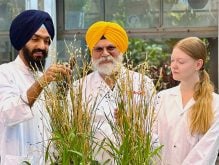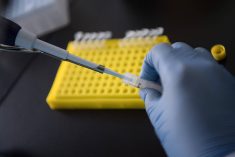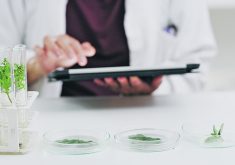The latest technology can now edit multiple genes in plants while simultaneously changing the expression of other genes
In 2012, a powerful molecular gene-editing tool known as CRISPR-Cas9 was discovered by American scientist Jennifer Doudna and French scientist Emmanuelle Charpentier and their colleagues. It was a game-changer in refining the DNA of crops to improve qualities like yield, growth and drought and pest resistance. The discovery earned the scientists the 2020 Nobel Prize in chemistry.
Now, scientists at the University of Maryland have taken that technology to a new level with a smart CRISPR that can multi-task.
“Current CRISPR tools can do gene editing, gene activation and gene repression,” said Yiping Qi, associate professor in the plant science department and co-author of the study.
Read Also

Wildfires have unexpected upside this year
One farmer feels smoke from nearby wildfires shrouded the July skies and protected his crop from the sun’s burning rays, resulting in more seeds per pod and more pods per plant.
“However, they are just like the tools in the Swiss Army knife, which can be used solely for one purpose at a time. But on the other hand, we now have smart phones which run multiple apps simultaneously, which is very powerful as it brings a lot of conveniences.
“In genome editing base breeding in crops, we are facing hurdles of lengthy plant life cycle (from seed to seed) and the challenge of plant tissue culture. All these problems motivated us to develop a smarter CRISPR technology that can run two ‘apps’ at a time, which led to the birth of CRISPR-Combo.”
The new technology is a method to edit multiple genes in plants while simultaneously changing the expression, or behaviour, of other genes. It will enable genetic engineering combinations to work together to boost functionality and improve the breeding of crops.
“It confers complex and smart genetic engineering as one can simultaneously edit one gene while activating the same or another gene,” said Qi. “The smartness comes if one can design one process to help the other, as we showed in the research paper to have gene activation to help the genome editing process.”
A number of benefits arise from being able to manipulate more than one gene at a time. For instance, blight can decimate wheat fields and threaten farmers’ livelihoods. If scientists can use the technology to remove a gene from wheat that makes it susceptible to blight while, at the same time, turn on genes that shorten the plant’s life cycle and increase seed production, they could produce blight-resistant efficient wheat before the disease does damage.
Qi and his team developed CRISPR methods whereby they could regulate gene behaviour in plants and at the same time edit multiple genes. They used tomato and rice cells to demonstrate.
“As a proof of concept, we showed that we could knock out gene A and upregulate, or activate, gene B successfully without accidentally crossing over and knocking out gene B or upregulating gene A,” he said.
Using rockcress, the team edited a gene to make the plant more resistant to herbicides while, at the same time, activated a gene to bring about early flowering and therefore more seed production. The result was a herbicide-resistant plant that yielded eight generations in one year rather than the usual four generations.
“My lab is interested in developing and applying transcriptome regulation tools in plants,” said Qi. “Such tools will enable the engineering of resilient crops through transcriptome reprogramming, which is at the heart of plant development, reproduction and responses to environmental stresses.”
A plant’s DNA contains the instructions to build and maintain cells. For those instructions to be carried out, DNA must be ‘read’ and transcribed, or copied, into RNA. The gene readouts are called transcripts, and a transcriptome is the collection of all the readouts in a cell.
An RNA sequence mirrors the DNA sequence from which it was copied. By analyzing the RNA sequences in a cell, researchers can find out when and where each gene is turned on or off.
The media release stated that growing genetically engineered plants from tissue cultures requires the addition of growth hormones to activate the growth promoting genes. Using rice, the researchers activated these genes with CRISPR-Combo. That resulted in gene-edited rice from tissue cultures that did not need hormone supplementation.
Qi’s team found that tissue cultures grown with the CRISPR-Combo approach resulted in more of the edited gene than tissue exposed to growth hormones.
“This method results in a highly efficient genome editing process,” said Qi.
The application of CRISPR technology is still relatively new in the plant breeding community. However, the new combo development has interested other scientists. Qi recently returned from the annual meeting of the Society for In Vitro Biology in San Diego and said that many people had heard of his research and spoke highly of the work. In the breeding community he is hearing from those in the biotech field.
“I heard from scientists from different biotech companies who are actively researching and using genome editing tools,” he said. “I don’t think conventional breeders have started using CRISPR in most parts of the world. Things, though, are changing quickly as many countries seem to consider some genome-edited crops as conventionally bred crops.
“In my opinion, this science-based approach for regulation should be applauded. Compared to conventional breeding, genome editing is more precise and predictable without introducing unnecessary mutations and DNA recombinations (as conventional breeding always does).”
The team plans to conduct experiments in citrus, carrots and potatoes to test the viability of the technology in a fruit, vegetable and staple crops. They are also working on creating a herbicide-resistant golden rice with enhanced nutritional content as well as red rice with increased antioxidants.
“We are working on adding more functionality to upgrade the system,” said Qi. “We are also working on more demonstrations of the combo system in different crops. The possibilities are really limitless in terms of the traits that can be combined. What is exciting is that CRISPR-Combo introduces a level of sophistication to genetic engineering in plants that we haven’t seen before.”
The research was published in the journal Nature Plants.















